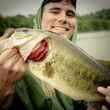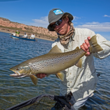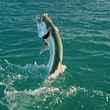Ernie always swings for the fences. This has been his m.o. since he was a pup, and he shows no signs of throttling back and adopting a more measured, moderate approach. You’d think that at his age he’d be satisfied simply to make contact and get on base once in a while, but that’s not Ernie’s style. If he can’t knock it out of the park he’ll take a mighty cut and go down swinging, dammit.
If nothing else he’s proved true to the spirit of his namesake: Ernie Banks, the Cubs Hall-of-Famer who expressed his boundless joy for the game in his signature phrase “Let’s play two!”
Still, after straining to pick up the faint beep-beep-beep that signals a point and realizing Ernie was so far away I might not get to him before one of us died of starvation, my shoulders sagged in despair. The distance was probably no more than a couple hundred yards, but what would have been a walk in the park on the prairies promised to be a somewhat less pleasant exercise in the bristling second-growth of northern Wisconsin.
I scraped through the briars, stopped to regain my bearings, and was dismayed when the beeper seemed just as faint as ever. Muttering something unprintable, I started off again and after a ridiculously long interlude finally glimpsed Ernie through an opening in the popple. He was ahead and a little to my right in a patch of fractionally lighter cover, and everything about his body language—the high-hoisted flag, the slightly cocked head, the almost hypnotized expression—screamed that the bird was right there.
It was. The woodcock came up hard but went down the same way, the Fox seeming to rise and fire of its own volition as the pear-shaped bird whistled through the canopy. Ernie pointed another woodcock perhaps 50 yards from the first, the Fox again swung true, and having shot a bird earlier in the day over my younger setter, Tina, my limit was filled.
That doesn’t happen as regularly as it used to.
I’m not sure how you quantify these things, but over the years the woodcock has probably meant more to my dogs and me than any other gamebird. It has given us more pleasure, more satisfaction, and certainly more opportunity. I couldn’t begin to count the number of points my dogs have made on woodcock, and what this has contributed to their overall development is, again, impossible to quantify.
I don’t think it’s a coincidence, though, that the strongest bird-finder and best all-around dog I’ve ever owned, an English setter named Emmylou, came of age in a time and place that afforded her just a silly number of woodcock contacts. “It takes birds to make a bird dog,” goes the old adage, and in my experience Miss Emmy, thanks to the scads of woodcock she encountered and learned from, stands as Exhibit A.
Of course the reluctance or even outright refusal of some dogs to retrieve woodcock, often with amusing consequences, is one of the time-honored (or maybe time-worn) tropes of outdoor writing. While I’ve heard of this, I’ve never observed it personally. The dogs I’ve hunted over seemed no more or less enthusiastic about retrieving woodcock than they were about any other gamebird. On at least one occasion my old setter, Zack, dropped a woodcock mid-retrieve that was never recovered, but I don’t think he was editorializing. I think he just figured his time would be better spent looking for another woodcock to point.
Woodcock are unsurpassed in their willingness to hold for a point, but this doesn’t necessarily lead to the conclusion that the most effective way to hunt them is with pointing dogs. I like to say that woodcock inhabit places where light goes to die, and when you wade into them to flush a tight-sitting bird you gain new perspectives on helplessness. If you get any shot at all, it’s likely to leave you augered-in so deeply that you’ll have to have your hunting buddies come over and unscrew you.
This helps to explain why an industrious flushing dog—a dog that’ll dive, burrow, or bore into the cover so you don’t have to—can be such a delight to gun woodcock over. The Brits, who’ve been at this for a while, came up with a dog so adept at rousting woodcock from heavy cover they named it for the game: the cocker spaniel. Standing in the open while a cocker beats the thick stuff … well, depending on your abilities with a scattergun, it’s either great sport or almost unfair.
Woodcock aren’t to everybody’s taste on the table, although among epicures their reputation is second-to-none. The classic European presentation is to roast the birds whole, plucked but undrawn, in a very hot oven, then serve them with a sauce made from the minced “trail”—the guts, essentially—some cognac, and a little fois gras.
I ate woodcock this way once, as the guest of an eccentric Francophile who played the violin, claimed to have studied philosophy at the Sorbonne, and was convinced that Matt Groening, the creator of The Simpsons, is the Kafka of our time. He had a world-class wine cellar—he decanted a 30-year-old Burgundy to accompany our dinner—but hunted with a Poly-Choked Ithaca pump. He also had a wonderful little cocker that he’d trained entirely in French, his theory being that if the dog were ever lost or stolen it would appear to be a complete idiot, thus making it more likely that the dog would be returned to him.
The roasted woodcock were okay, although I bit off more than I could chew, literally, when I followed my host’s lead and popped an entire woodcock head into my mouth as if it were a meatball on a toothpick. He called it the pièce de résistance, but in my case it was the prelude to acute gastric distress.
These days most of my woodcock find their way into a kind of faux paté made with cream cheese, chopped mushrooms, a few spices, and a couple tablespoons of Calvados, cognac, of whatever spirit I’m moved to include. It may break the rules, but it’s awfully yummy.

Woodcock gladden my hear whenever and wherever I find them. I always look forward to running the dogs on them in March and April, when they return from their southern wintering grounds. I’ve located several hens on nests that way, and occasionally I even scatted a brood of golfball-sized hatchlings. At that point I immediately back off, collar the dogs, and call a halt to the spring “hunting” season.
And it’s always a special pleasure to witness the male woodcock’s twilight courtship flight, the spectacular aerial ballet that inspired Aldo Leopold’s famous description “dancers in the sunset sky.”
After puffing himself up, strutting around and uttering a series of loud, nasal peents, the male woodcock launches himself skyward, rising in tightening spirals until he’s just a smudge against the purpling canopy of dusk. He hovers for several seconds, batlike; then, following a series of high-pitched chirping calls, he plummets earthward in a breathtaking free-fall, righting himself only at the last moment, landing within a few feet of where he took off, and starting his routine all over again. On moonlit nights he may dance right through ‘til dawn, hoping to attract a mate and do his part to perpetuate his kind.
No bird exemplifies the hunter’s paradox of killing what you love more poignantly than the woodcock. Distraught over the bird’s dwindling numbers, the revered author Robert F. Jones vowed one off-season that his days of shooting woodcock were done. But he found, hunting the sun-dappled covers near his Vermont home with his dogs Jake and Roz, that he couldn’t remain true to his pledge.
“The hunter in my heart,” he wrote, “will have his way.”
As he will in mine.

































Comments